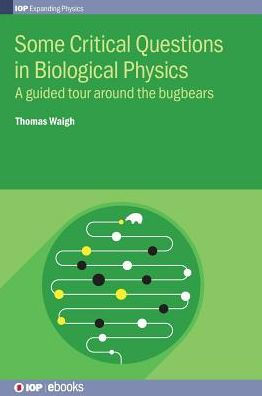Table of Contents
Preface xiii
Acknowledgements xix
Author biography xxi
1 Molecular communication-crackling phone lines 1-1
1.1 Introduction 1-1
1.2 Suggested reading 1-7
1.3 Technical details 1-8
1.3.1 Definition of information 1-8
1.3.2 Bandwidth calculation 1-8
1.3.3 Information theory 1-9
1.3.4 The Rab switch model 1-10
References 1-11
2 How dynein works and other motor proteins 2-1
2.1 Introduction 2-1
2.2 Suggested reading 2-6
2.3 Technical details 2-6
2.3.1 Nanomotors 2-6
2.3.2 Vicsek model for shoaling of nanomotors 2-7
2.3.3 Viscosity in bacterial suspensions-experimental data 2-8
References 2-9
3 How brains work-wiring and consciousness 3-1
3.1 Introduction 3-1
3.2 Suggested reading 3-5
3.3 Technical details 3-5
3.3.1 What is a phase transition? 3-5
3.3.2 Order parameter 3-6
3.3.3 BOLD contrast with magnetic resonance imaging 3-6
References 3-7
4 Spike trains and the senses-the mouse's whiskers 4-1
4.1 Introduction 4-1
4.2 Suggested reading 4-5
4.3 Technical details 4-6
4.3.1 The Euler-Bernoulli equation 4-7
4.3.2 Spike coding 4-9
References 4-9
5 Elastic turbulence-gloopy chaos 5-1
5.1 Introduction 5-1
5.2 Suggested reading 5-6
5.3 Technical details 5-7
5.3.1 Turbulence 5-7
5.3.2 Kolmogorov/Richardson theory for classical turbulence 5-7
5.3.3 Turbulent spectra 5-8
References 5-10
6 How mucus works-the 21 mysteries in man 6-1
6.1 Introduction 6-1
6.2 Suggested reading 6-8
6.3 Technical details 6-9
6.3.1 Varieties of comb biopolymer 6-9
6.3.2 Gelling mucins 6-10
6.3.3 Epithelial mucins 6-10
6.3.4 Viscosity 6-11
6.3.5 Aggrecan 6-11
References 6-12
7 Synthetic biology-reengineering bugs and molecules 7-1
7.1 Introduction 7-1
7.2 Suggested reading 7-6
7.3 Technical details 7-7
7.3.1 Genetic engineering 7-7
7.3.2 How to engineer a bacterium 7-7
7.3.3 How to engineer DNA 7-8
7.3.4 How to engineer peptides 7-8
7.3.5 The repressilator 7-9
References 7-9
8 Missing instruments-grease monkeys required 8-1
8.1 Introduction 8-1
8.1.1 Raman spectroscopy 8-4
8.1.2 Magnetic resonance imaging 8-5
8.1.3 Super-resolution fluorescence microscopy 8-6
8.1.4 Optical coherence tomography 8-7
8.1.5 Cryo transmission electron microscopy 8-8
8.1.6 Coherent x-ray imaging 8-8
8.1.7 Context 8-9
8.2 Suggested reading 8-9
8.3 Technical details 8-10
8.3.1 Raman spectroscopy 8-10
8.3.2 Non-linear Raman spectroscopy 8-10
8.3.3 Magnetic resonance imaging 8-11
8.3.4 Optical coherence tomography 8-12
8.3.5 Super-resolution fluorescence microscopy (STORM) 8-13
8.3.6 Coherent x-ray imaging 8-15
References 8-15
9 The structure of carbohydrates-the perfect chip 9-1
9.1 Introduction 9-1
9.2 Suggested reading 9-7
9.3 Technical details 9-7
9.3.1 Gallery of carbohydrates 9-7
9.3.2 Boat and chair conformations 9-8
9.3.3 Blurred diffraction patterns 9-8
9.3.4 Model of helical lamellae in potatoes 9-8
9.3.5 Phase transitions in food 9-9
9.3.6 Glycoproteins 9-11
9.3.7 Proteoglycans 9-12
References 9-12
10 Evolution and antibiotics-Bugmageddon 10-1
10.1 Introduction 10-1
10.2 Suggested reading 10-9
10.3 Technical details 10-10
10.3.1 Game theory with bugs 10-10
10.3.2 Bacterial population mathematics 10-10
10.3.3 Electrical communication in biofilms 10-11
10.3.4 Capsules 10-11
10.3.5 Physics of biofilms 10-12
References 10-13
11 The regulation of expression in DNA-huge uncertainties in genetics 11-1
11.1 Introduction 11-1
11.2 Suggested reading 11-7
11.3 Technical details 11-8
11.3.1 Central dogma of biology 11-8
11.3.2 DNA 11-8
11.3.3 Chromosomal structure 11-8
11.3.4 RNAP 11-9
11.3.5 Ribosome 11-9
References 11-10
12 The origin of sub-diffusion inside cells-everything's gone fractional 12-1
12.1 Introduction 12-1
12.2 Suggested reading 12-7
12.3 Technical details 12-7
12.3.1 The fractal exponent of Mickey Mouse 12-7
12.3.2 Definition of sub-diffusive motion 12-8
12.3.3 Protein springs 12-10
References 12-11
13 Microrheology-the unexplored continents 13-1
13.1 Introduction 13-1
13.2 Suggested reading 13-7
13.3 Technical details 13-8
13.3.1 Viscoelasticity of silly putty 13-8
13.3.2 Swirling motor proteins 13-8
13.3.3 Mucin viscoelasticity 13-8
13.3.4 Scaling model for polyelectrolyte comb viscoelasticity 13-9
References 13-11
14 Quantum phenomena in biology-the role of chunks 14-1
14.1 Introduction 14-1
14.2 Suggested reading 14-5
14.3 Technical details 14-5
14.3.1 Anharmonic potentials 14-5
14.3.2 Hoffmeister series 14-7
14.3.3 Hydrogen bond potential 14-7
References 14-8
15 The structure of membranes-uncharted factories 15-1
15.1 Introduction 15-1
15.2 Suggested reading 15-5
15.3 Technical details 155
15.3.1 Fluctuations of vibrating tubules 15-6
References 15-7
16 Drug delivery-gene therapy and other stories 16-1
16.1 Introduction 16-1
16.2 Suggested reading 16-6
16.3 Technical details 16-6
16.3.1 Gene therapy 16-6
16.3.2 Endocytosis 16-7
16.3.3 Viscosity of colloidal suspensions and jamming 16-8
References 16-8
17 A good model for polyelectrolytes-bootstrapping with a many-body problem 17-1
17.1 Introduction 17-1
17.2 Suggested reading 17-6
17.3 Technical details 17-6
17.3.1 Scaling model of polyelectrolytes 17-6
17.3.2 Electrophoresis 17-7
17.3.3 Rayleigh charge instability 17-7
References 17-8
18 The activity of hearts-the pump that quivers 18-1
18.1 Introduction 18-1
18.2 Suggested reading 18-5
18.3 Technical details 18-6
18.3.1 Anatomy of a heart 18-6
18.3.2 Hodgkin-Huxley equations 18-7
18.3.3 Reaction-diffusion equation 18-7
References 18-8
19 A perspective 19-1






